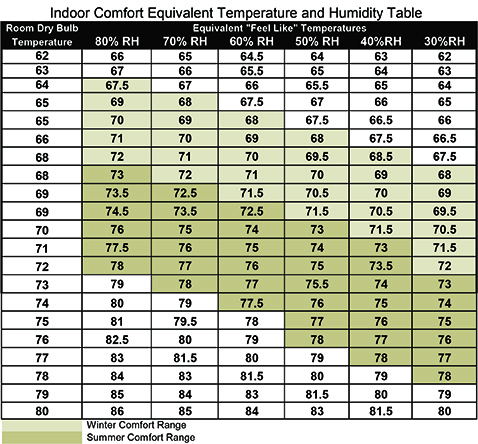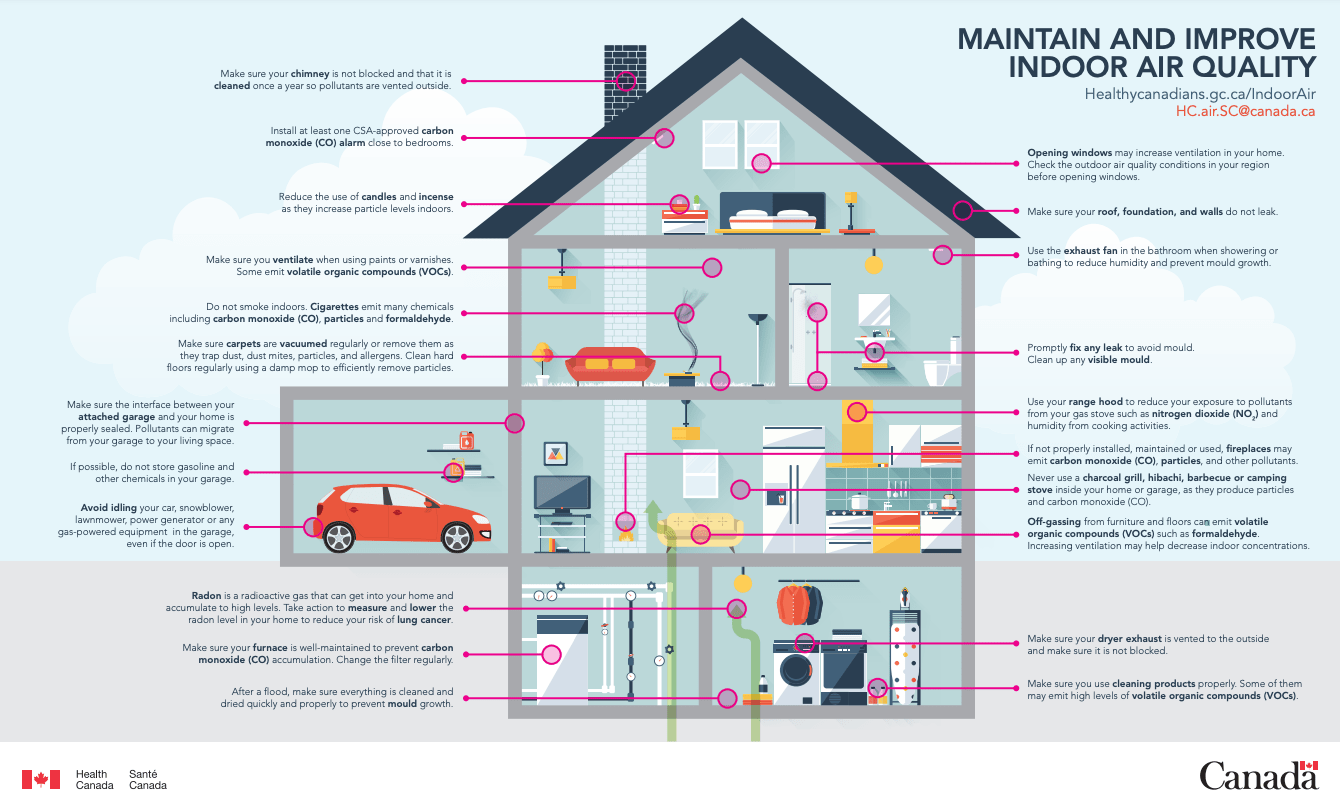
According to the Ontario Ministry of Environment, an average adult breathes in around 15,000 litres of air every day[1]. Statistically, people spend 90% of their time indoors[2]. The majority of that time is spent at home, therefore it is extremely important that our homes provide a healthy living environment.
Indoor Air Quality (IAQ) refers to the air quality within buildings and structures relating to the health and comfort of their occupants and is influenced by the interaction of many variables and processes. Some of those variables are external to the building, while others are controlled/determined by the architect, builder, and occupants.
Indoor Air Quality is a complex subject to discuss as we are still learning the long term effects on human health from different materials, off gassing, high humidity levels, and soil gases in our homes.
What we can be sure of is: indoor air quality is an important design consideration when building or renovating a home. Unfortunately, IAQ is often overlooked.
- Relative humidity
Relative Humidity is one important factor that affects comfort and health. Air that is too dry can result in chapped skin, bleeding noses and respiratory problems for some people. Air that is too humid can cause mould growth. Health Canada recommends that a home’s relative humidity be kept between 30-55 percent (depending on your climate zone) as shown on the graph below.

- Airborne particulate matter
Airborne particulates vary in size from visible dust to nanoparticles and can penetrate deep into the lungs. Small particles tend to agglomerate to larger particles. Larger particles will settle rapidly and deposit on surfaces like carpets, flooring and furniture. Particles are also excellent sorbents and thus carriers for Semi Volatile Organic Compounds (SVOC).
- Volatile Organic Compounds (VOC)
VOCs are emitted from materials, cleaning and consumer goods and have a major effect on air quality. Some VOCs can be clearly detected by their odours but others are non-odorous at “normal” indoor concentrations. In other words, the absence of odours doesn’t mean the absence of potential harmful contaminants! Most common VOCs found in homes:
- Benzene: paint glue, carpeting and gasoline combustion
- Butanal: emissions from barbecues, burning candles, stoves and cigarettes
- Ethanol: glass cleaners, dishwasher detergents and laundry detergents
- Formaldehyde: floor lacquers, particle boards and certain molded plastics
- Mould
Moulds are microscopic fungi. They grow on organic materials and can proliferate forming spores. Mould needs oxygen, water, organic nutrients and a suitable temperature (between 0°C and 38°C) to grow. When mould grows on building materials, the resulting spores may become airborne and trigger various adverse health effects. Mould can grow on nearly all organic materials, like paper, cardboard, ceiling tiles, wood, and wood products. Paint, wallpaper, some insulation materials, dry wall, carpet, fabric and dust can also support mould growth.
- Combustion gases
When there is a negative pressure inside a house, naturally vented appliances such as fuel-fired furnaces, wood burning fireplaces, and natural aspirating domestic hot water tanks can draw combustion gases into the living spaces. The source of combustion air should be properly sized and located following building code compliance.
- Radon
Radon is an odourless, colourless, radioactive gas that occurs naturally when the uranium in soil and rocks break down. Outdoors, radon is diluted in the air and is not a concern. However, radon can move through small spaces under a house and seep into enclosed spaces, like basements, and can sometimes accumulate to relatively high levels and become hazardous for health; radon is the leading environmental cause of lung cancer[3]. See more information about radon on the Radonaware website. For code changes to the 2018 BC Building Code regarding radon, click here.
How to design for good air quality?
Designing for good indoor air quality involves all members of the designing and building team to work collaboratively and to maintain their focus on the goal of achieving good indoor air quality. The strategies for good indoor air quality and energy efficiency are complementary; both require a well-sealed building envelope and controlled ventilation.
- The building site
The building site determines the ambient air quality. Knowing that we can’t always choose the site location, it is important for designers and builders to incorporate appropriate measures to eliminate potential problems ( ie radon and other soil gases).
- Overall Architectural design
Making sure there is adequate room for ventilation systems such as an HRV (heat recovery ventilation) and paying attention to home owners’ hobbies and activities is important. For example: Adding extra ventilation for fry kitchens, work shops, and art studios is crucial for healthy IAQ.
- Airtight building envelope
Constructing a durable building envelope that is airtight will prevent deterioration and protect assemblies from moisture issues. This will help reduce the possibility of rot and mould growth. It will also ensure outdoor air does not sneak into the house and will allow homeowners to control the fresh air intake through a well designed balanced and properly sized ventilation system. This has been especially relevant in the past few summers in British Columbia, and other parts of Canada, where smoke from forest fires were damaging buildings and homes. See our post on smoke and air tightness here.
- Ventilation and Climate control
Ventilation and air filtration systems are necessary to minimize problems related to humidity, building pressure, particulate matter, and combustion gases. High-humidity rooms like kitchens and bathrooms should have exhaust fans and ventilation filters should be cleaned/changed frequently.
- Materials selection
Material and product selection is crucial for minimizing the concentration of chemical contaminants in our homes. There are many options for choosing low or zero VOC materials for example: low-formaldehyde or sealed wood products for cabinetry, zero VOC paints, green rated carpets (such as Green Label Plus). Other options to consider would be limiting the use of carpeting and synthetics like vinyl wall coverings and plastic moldings, using low-emission duct sealants, tapes, and caulking, and using ceramic tiles or pre-finished hardwood flooring.
- Construction process and occupancy
VOC emissions from building materials, furniture, and cabinetry may sometimes last for the lifetime of the home. Providing increased house ventilation during and after the installation of high-emitting materials such as caulking, coatings and carpet will improve the air quality as well as actively ventilating at the beginning of the occupancy if the homeowners move in quickly after construction. We can all relate to the “new car” smell.
How to improve indoor air quality?
The below image from Heath Canada gives homeowners recommendations on ways to maintain and/or improve the indoor air quality of their home.


